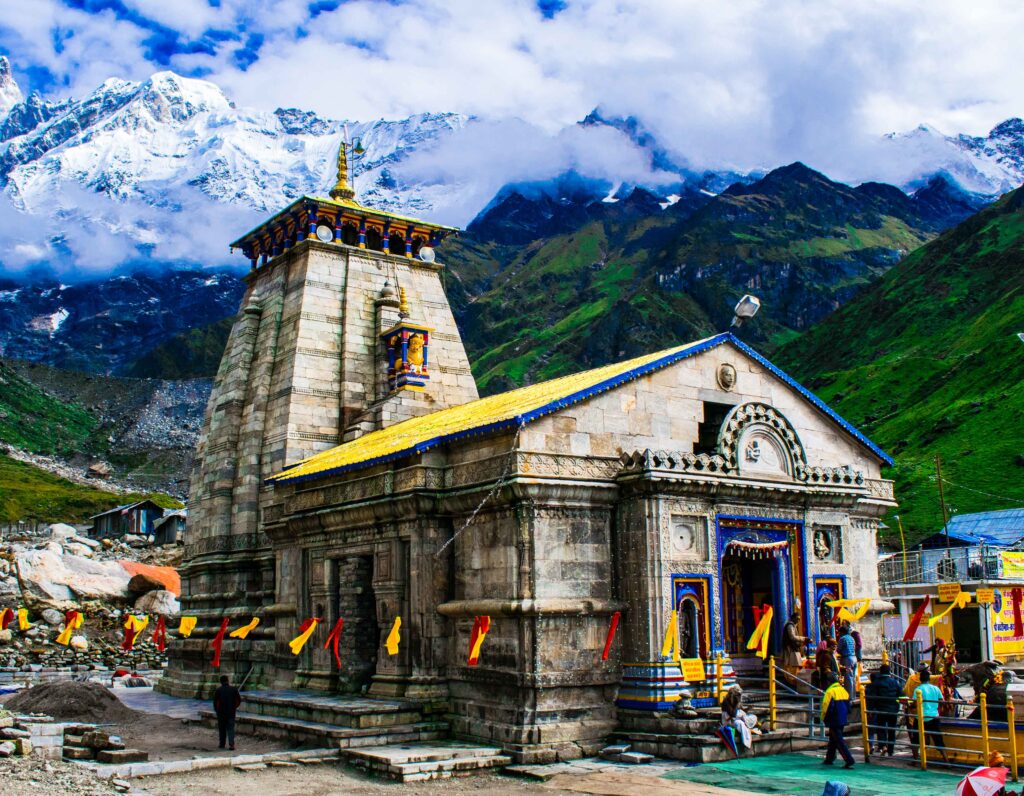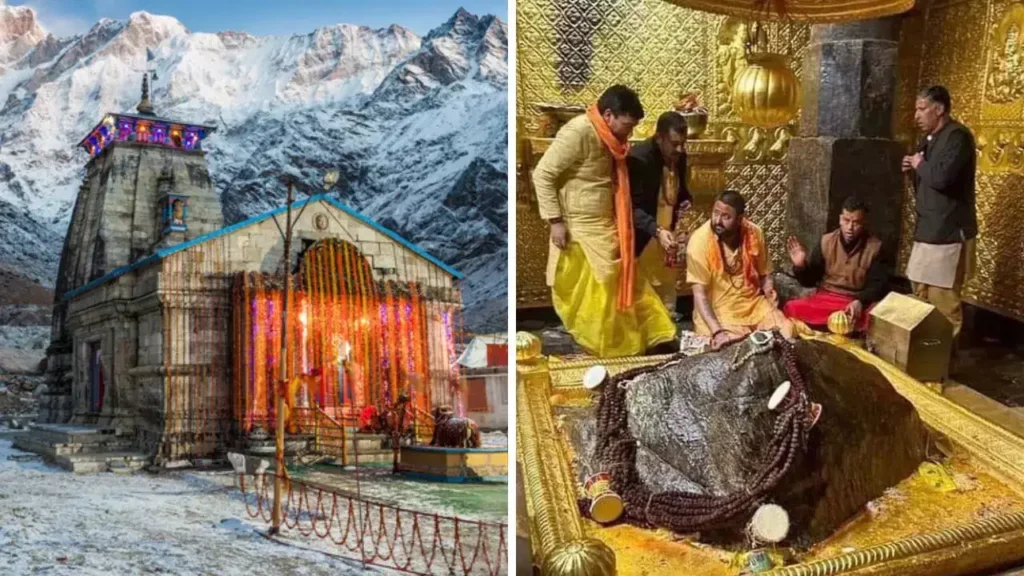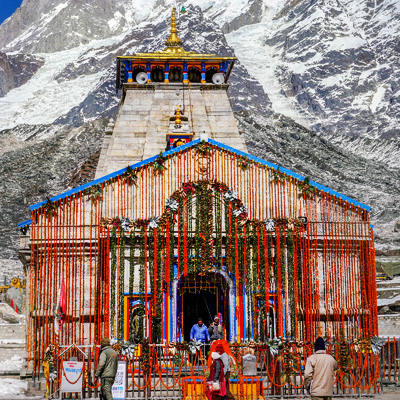Table of Contents
Introduction
Kedarnath Dham is a sacred Hindu temple and one of the twelve Jyotirlingas dedicated to Lord Shiva. The unique triangular-shaped Jyotirlinga at Kedarnath is also one of the four sites in the Chhota Char Dham pilgrimage circuit. Located near the Mandakini River in the Rudraprayag district of Uttarakhand, India, the temple is surrounded by majestic mountains on three sides. Due to heavy snowfall in the region, the temple closes every winter season.
The routes to Kedarnath are inaccessible from November (Kartik Purnima) to April or May (Akshaya Tritiya). Two days after Diwali, the temple doors are closed for six months, and they reopen with great celebrations in spring. A visit to Kedarnath is often followed by a journey to Badrinath Dham.

History Of Kedarnath Dham
Kedarnath Dham has a rich historical and mythological significance. It is believed that the temple was originally built by the Pandavas thousands of years ago. After emerging victorious in the Kurukshetra war, the Pandavas sought Lord Shiva’s blessings to atone for their sins. However, Lord Shiva, not wanting to meet them, disguised himself as a bull near what is now Guptkashi. Bhima, the second Pandava, recognized Shiva in his disguise and attempted to catch him.
In the ensuing chase, the bull’s body disintegrated into five parts, which fell at different locations—Tungnath, Rudranath, Madhyamaheshwar, Kalpeshwar, and Kedarnath—collectively known as the Panch Kedar. The Pandavas built temples at these sites to honor Lord Shiva and seek his forgiveness.
The present-day Kedarnath temple was re-established by Adi Shankaracharya in the 8th century. It is said that the temple remained buried under snow for approximately 400 years, which preserved its structure. The temple’s resilience and sacred aura continue to attract millions of devotees annually.

7 surprising facts about Kedarnath Dham:
- Ancient Origin: Kedarnath temple is over 1,200 years old and built by the Pandavas, according to legend.
- No Mortar Used: The temple is constructed entirely of massive interlocking stones.
- Survived Natural Calamities: It miraculously withstood the devastating floods of 2013 with minimal damage.
- Height Above Sea Level: Located at a breathtaking altitude of 3,583 meters (11,755 feet).
- Only Accessible Half the Year: Due to harsh winters, the temple remains closed for six months annually.
- Mysterious Natural Lingam: The Shiva Lingam inside the temple is believed to naturally emit warmth.
- Adi Shankaracharya’s Connection: The revered saint established the temple’s rituals and is said to have attained moksha here.
How to Reach Kedarnath Dham
Reaching Kedarnath Dham requires careful planning due to its remote location and the challenging terrain. Here are the ways to reach this sacred site:
By Air
The nearest airport to Kedarnath is Jolly Grant Airport in Dehradun, located about 239 kilometers away. From the airport, travelers can book a taxi or take a shared cab to Gaurikund, the base camp for the Kedarnath trek. The journey offers stunning views of the Himalayan landscape.
By Train
Travelers can reach Kedarnath Dham by taking a train to nearby stations such as Dehradun, Rishikesh, Haridwar, or Kotdwar. These railway stations are approximately 200 kilometers from Kedarnath. From the station, one can hire a taxi or take a bus to reach Sonprayag and then proceed to Gaurikund.
By Road
Buses and private vehicles are widely used to reach Kedarnath. The nearest bus stand is in Sonprayag, from where travelers can hire a taxi to Gaurikund. Prior to the devastating floods in 2013, buses could reach Gaurikund directly. However, the last bus stop has now been shifted to Sonprayag.
From Gaurikund to Kedarnath
The final stretch from Gaurikund to Kedarnath covers approximately 16 kilometers. Pilgrims can choose between trekking, mule rides, or helicopter services to complete the journey. Helicopter services are available from places like Phata and Guptkashi, providing a convenient and scenic option for those unable to trek.
Best Time to Visit
The ideal time to visit Kedarnath is between April and June, as well as September and October. During these months, the weather is pleasant, and the temple remains open to devotees. Monsoon months (July and August) are not advisable for travel due to heavy rainfall, landslides, and slippery routes.
Spiritual Significance
Kedarnath Dham holds immense spiritual importance for Hindus. It is believed that a visit to this temple not only cleanses the soul but also fulfills one’s desires. The temple’s serene location amidst the Himalayas enhances its divine atmosphere, providing a perfect setting for meditation and worship.
The rituals performed at Kedarnath include special prayers, abhishekam (ritual bathing), and offerings to Lord Shiva. Devotees often chant the Shiva Panchakshara mantra, “Om Namah Shivaya,” to seek blessings and inner peace.
Nearby Attractions
While visiting Kedarnath, pilgrims often explore nearby spiritual and natural attractions:
- Badrinath Dham: Part of the Char Dham pilgrimage, Badrinath is dedicated to Lord Vishnu and is located approximately 220 kilometers from Kedarnath.
- Vasuki Tal: A high-altitude lake surrounded by snow-capped peaks, Vasuki Tal offers a serene retreat for trekkers and nature lovers.
- Guptkashi: Known for the ancient Vishwanath Temple and Ardhnareshwar Temple, Guptkashi holds its own spiritual significance.
- Chorabari Tal (Gandhi Sarovar): A glacial lake located near Kedarnath, it is said to be the place where Mahatma Gandhi’s ashes were immersed.
Tips for Travelers
- Ensure you are physically fit for the trek or opt for helicopter services if needed.
- Carry warm clothing, sturdy footwear, and a first-aid kit.
- Avoid visiting during the monsoon season due to the risk of landslides.
- Respect the local culture and follow the guidelines provided by temple authorities.
Conclusion

Kedarnath Dham is not just a temple; it is a journey of faith, resilience, and spiritual awakening. Its history, architectural marvel, and breathtaking surroundings make it a must-visit destination for devotees and travelers alike. Whether you trek through its challenging paths or take a helicopter ride, the experience of standing before the sacred Jyotirlinga is unparalleled. A visit to Kedarnath is a soul-stirring journey that leaves an indelible mark on the hearts of all who undertake it.